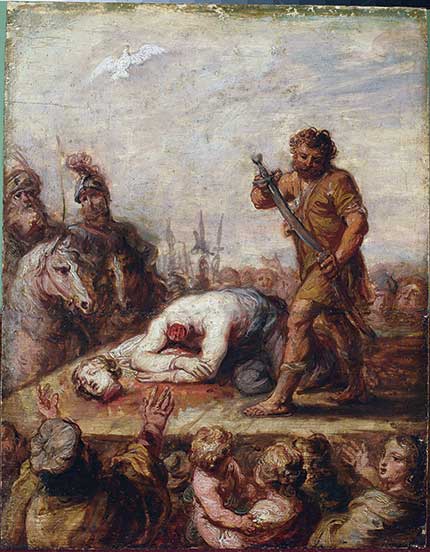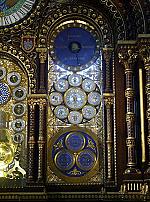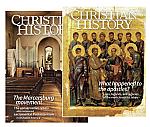Celebrating the saints: the sanctoral cycle

[ABOVE: Abraham van Diepenbeeck, The Martyrdom of Saint Catherine, c. 1640. Oil on oak panel—National Museum, Warsaw / Public domain, Wikimedia]
As we mentioned in the FAQs (pp. 2–3), two cycles of time run concurrently in the church year. The yearly cycle of feasts that we have discussed for most of this guide is called the “temporal” cycle, and the cycle of remembrances of specific saints is called the “sanctoral” cycle—“sanctoral” means “of a saint.” While Christians of all denominations often use the word “saint” to denote any person who lived a holy life and presumably now enjoys the presence of the Lord, some groups have also come up with formal lists of official saints to be more broadly recognized.
Where did it come from?
Sometime around the year 155 (or possibly 167), Polycarp, aged bishop of Smyrna and former disciple of John the Evangelist, died as a martyr at the hands of the Roman government. His martyrdom account, one of the earliest we have, states that his own disciples took his bones and placed them in “a fitting place”; there, they added, “the Lord shall grant us to celebrate the anniversary of his martyrdom, both in memory of those who have already finished their course, and for the exercising and preparation of those yet to walk in their steps.”
This is the earliest reference to honoring both the death date and the earthly remains of someone who had died for Christ. What began with Polycarp’s disciples meeting for prayer at his grave, grew, after the legalization of Christianity in the fourth century, into a much more systematic engagement with the memory of saints.
How is the date determined?
Saints are normally honored on the anniversary of their death (this idea dates all the way back to the time when most of those honored in this way were martyrs, as we see with Polycarp). Feast days throughout the church year also celebrate events (such as the Annunciation to the Virgin Mary) or doctrines (such as Trinity Sunday); these dates have been solidified through the centuries in various ways, and we’ve mentioned some of the most famous ones throughout this guide. Guidebooks and calendars of saints, both print and online, offer helpful lists—some are mentioned in the “Recommended Resources” (pp. 50–51). Roman Catholicism distinguishes between solemnities (which normally celebrate major doctrines or events from the life of Jesus or the Virgin Mary), other lesser feasts, and memorials. Orthodoxy differentiates between Great Feasts (see p. 45), which are mostly related to the life of Jesus or the life of the Virgin Mary, and other celebrations.
In Roman Catholicism bishops and other local leaders originally held the responsibility for recognizing (canonizing) local saints as worthy of remembrance—especially on the date of their death. In 993 Pope John XV became the first pope to canonize a saint who was not local to Rome. Local canonizations initially continued, but in 1170 Pope Alexander III released a decree that canonization was the pope’s sole prerogative. This continues to be the case for Catholics. In Catholicism today the process generally begins with research on a deceased holy person at a local or diocesan level, then moves to the general church level. Candidates for canonization are usually declared “venerable” and then “blessed” as intermediate steps on the road; after it is believed that at least two miracles can be attributed to the saint’s intercession after his or her death, the pope officially canonizes the person.
In Eastern Orthodoxy, while the process (more frequently referred to as “glorification”) is similar, it is more decentralized. As in Catholicism it begins with research and a case being made on the local/diocesan level, which is then referred to a committee that formally studies the matter and issues a report to the Holy Synod, the governing body of an individual branch of the Orthodox church. Each branch (Greek Orthodox, Russian Orthodox, etc.) glorifies its own saints, though they will then inform other Orthodox churches that they have done so, and many famous saints are celebrated on multiple Orthodox calendars.
No formal process for canonizing a saint currently exists in any Protestant denomination. In denominations that regularly remember a set list of saints, the chief liturgical governing body of the church often makes that determination, publishes a calendar of saints, and provides worship resources around saints’ days. Protestant sanctoral calendars generally remember some of the most famous apostles, prophets, and martyrs celebrated in Catholicism and Orthodoxy, as well as famous holy people particular to their own denominational heritage.
Theological themes
At its best the remembrance of saints has served as a way to lift up the lives of faithful Christians from the past as models for us to emulate and as those urging us on from the nearer presence of Christ. Some of the traditional categories with which saints have been labeled in the West include apostles, evangelists, martyrs, confessors, doctors of the church, virgins, and matrons (holy women who were not virgins). Traditional categories in the East include apostles, prophets, martyrs, evangelists, fathers and hierarchs of the church, monastics/ascetics, and “the just” (those who lived a faithful life in the world rather than as clerics, nuns, or monks). Other categories sometimes used today include missionaries, reformers, teachers, pastors, ecumenists, apologists, and renewers of society. Sometimes “job titles” such as abbot, abbess, bishop, archbishop, priest, or deacon are also used in referring to a saint.
In both Catholicism and Orthodoxy, the church formally believes that saints may be venerated—that is, that some kind of honor may be given to them, and to relics of their bodies or possessions, which is different from the worship reserved for God alone. Since they are alive in Christ and in his nearer presence, people may ask for their intercessions, requesting them to ask Christ about certain situations or problems, just as one might request the prayers of a living holy person. Corruptions of these practices, especially when combined with belief in some sort of purgatorial state after death, have been a target of reformers for centuries and were part of what Protestants in particular were protesting about.
In general, Protestant denominations today that recognize saints do not have formal doctrines around veneration, intercessions, relics, and purgatory, just as they do not have official canonization processes. The official Protestant emphasis is on how the memory of these holy people exerts a moral influence on and gives an example for the living. Article XXI of the (Lutheran) Book of Concord gives one classic statement of this view:
For here a threefold honor is to be approved. The first is thanksgiving. For we ought to give thanks to God because He has shown examples of mercy; because He has shown that He wishes to save [people]; because He has given teachers or other gifts to the church. And these gifts, as they are the greatest, should be amplified, and the saints themselves should be praised, who have faithfully used these gifts. . . . The second service is the strengthening of our faith. . . . The third honor is the imitation, first, of faith, then of the other virtues, which everyone should imitate according to [his or her] calling.
Colors
Churches that follow a sanctoral calendar distinguish between martyrs—for whom the liturgical color is universally red for blood—and nonmartyrs—for whom the color is white in the West and green in the East. In the East feast days related to the life of Christ are celebrated in gold and those related to the Theotokos in blue; in the West the normal color for both of these is white.
In both East and West, only a very select number of feasts (and their colors) are allowed to override what would otherwise be normal for Sunday worship, so in most cases the colors mentioned here will be used for weekday celebrations of saints.
Customs
Individual saints and their days have developed many associations and celebrations over the years, and today some saints are recognized as patron saints of (as the Encyclopedia Britannica helpfully summarizes) “a person, a society, a church, an occupation, or a place.” This practice is thought to have initially arisen from the building of churches and associating them with saints and martyrs when Christianity was first legalized. If you are interested in learning more about practices historically or currently connected to a particular saint, plenty of online and print resources share these. Usually Scripture readings and prayers associated with observing a particular saint’s day are used in formal worship. Observances may also include special food, clothes, or events (parades, processions, etc.) connected to a saint’s celebration. Saints’ days, even those that remember martyrdoms, definitely emphasize the feast rather than the fast side of the church calendar.
Saints who have at one time or another been formally recognized number in the tens of thousands; liturgical reformers down through the centuries have frequently complained that days devoted to the saints are so numerous that they tend to take our focus away from the temporal cycle of the church year and its emphasis on Christ’s birth, life, death, and Resurrection. Thus the church has seen countless efforts to cut back or eliminate some saints’ celebrations entirely. This remains an ongoing debate. CH
Some things to do at home
• Most officially recognized saints have customs and food associated with their day and are the patron saint of something. Find saints with some connection to your story. Do you share a saint’s name? Were you born on a saint’s feast day? Does your region or your occupation have a patron saint? Learn more about the saints you discover, and perhaps eat their traditional food or practice a custom linked to them. For example Martin of Tours (November 11) is associated with lantern processions and eating goose; Saint Barbara (December 4) is associated with bringing branches into the house to bloom in wintertime and with eating boiled wheat.
This article incorporates text from “Memory and preparation” in CH #156.
By Jennifer Woodruff Tait
[Christian History originally published this article in Christian History Issue #156+ in 2025]
Jennifer Woodruff Tait is Senior Editor of CH magazineNext articles
Recommended resources: Fasts and Feasts
Learn more about the history of the Christian year, and get ideas for incorporating celebrations into your own life.
The editorsQuestions for reflection: Fasts and feasts of the church
Reflect on themes of sacred time.
The editorsDid you know? Vatican II
A helpful introduction to terms and ideas as you begin the Vatican II story
the editorsLetters to the editor, Vatican II issue
Readers respond to Christian History
our readers and editorsSupport us
Christian History Institute (CHI) is a non-profit Pennsylvania corporation founded in 1982. Your donations support the continuation of this ministry
Donate







